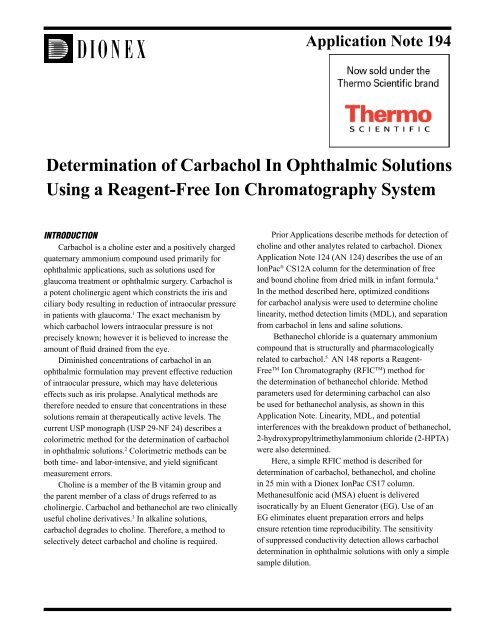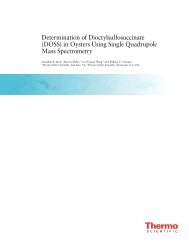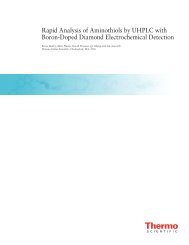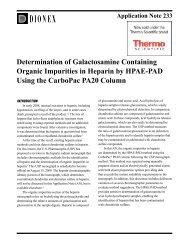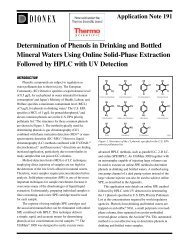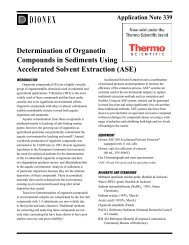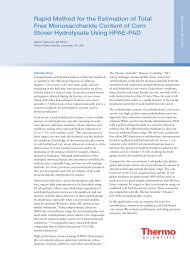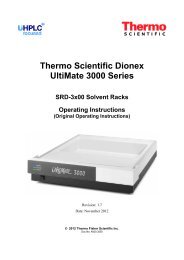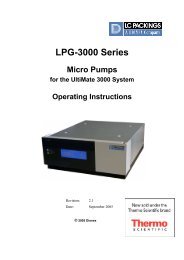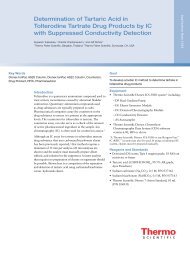AN 194: Determination of Carbachol in Ophthalmic Solutions Using ...
AN 194: Determination of Carbachol in Ophthalmic Solutions Using ...
AN 194: Determination of Carbachol in Ophthalmic Solutions Using ...
You also want an ePaper? Increase the reach of your titles
YUMPU automatically turns print PDFs into web optimized ePapers that Google loves.
Application Note <strong>194</strong><br />
<strong>Determ<strong>in</strong>ation</strong> <strong>of</strong> <strong>Carbachol</strong> In <strong>Ophthalmic</strong> <strong>Solutions</strong><br />
Us<strong>in</strong>g a Reagent-Free Ion Chromatography System<br />
INTRODUCTION<br />
<strong>Carbachol</strong> is a chol<strong>in</strong>e ester and a positively charged<br />
quaternary ammonium compound used primarily for<br />
ophthalmic applications, such as solutions used for<br />
glaucoma treatment or ophthalmic surgery. <strong>Carbachol</strong> is<br />
a potent chol<strong>in</strong>ergic agent which constricts the iris and<br />
ciliary body result<strong>in</strong>g <strong>in</strong> reduction <strong>of</strong> <strong>in</strong>traocular pressure<br />
<strong>in</strong> patients with glaucoma. 1 The exact mechanism by<br />
which carbachol lowers <strong>in</strong>traocular pressure is not<br />
precisely known; however it is believed to <strong>in</strong>crease the<br />
amount <strong>of</strong> fluid dra<strong>in</strong>ed from the eye.<br />
Dim<strong>in</strong>ished concentrations <strong>of</strong> carbachol <strong>in</strong> an<br />
ophthalmic formulation may prevent effective reduction<br />
<strong>of</strong> <strong>in</strong>traocular pressure, which may have deleterious<br />
effects such as iris prolapse. Analytical methods are<br />
therefore needed to ensure that concentrations <strong>in</strong> these<br />
solutions rema<strong>in</strong> at therapeutically active levels. The<br />
current USP monograph (USP 29-NF 24) describes a<br />
colorimetric method for the determ<strong>in</strong>ation <strong>of</strong> carbachol<br />
<strong>in</strong> ophthalmic solutions. 2 Colorimetric methods can be<br />
both time- and labor-<strong>in</strong>tensive, and yield significant<br />
measurement errors.<br />
Chol<strong>in</strong>e is a member <strong>of</strong> the B vitam<strong>in</strong> group and<br />
the parent member <strong>of</strong> a class <strong>of</strong> drugs referred to as<br />
chol<strong>in</strong>ergic. <strong>Carbachol</strong> and bethanechol are two cl<strong>in</strong>ically<br />
useful chol<strong>in</strong>e derivatives. 3 In alkal<strong>in</strong>e solutions,<br />
carbachol degrades to chol<strong>in</strong>e. Therefore, a method to<br />
selectively detect carbachol and chol<strong>in</strong>e is required.<br />
Prior Applications describe methods for detection <strong>of</strong><br />
chol<strong>in</strong>e and other analytes related to carbachol. Dionex<br />
Application Note 124 (<strong>AN</strong> 124) describes the use <strong>of</strong> an<br />
IonPac ® CS12A column for the determ<strong>in</strong>ation <strong>of</strong> free<br />
and bound chol<strong>in</strong>e from dried milk <strong>in</strong> <strong>in</strong>fant formula. 4<br />
In the method described here, optimized conditions<br />
for carbachol analysis were used to determ<strong>in</strong>e chol<strong>in</strong>e<br />
l<strong>in</strong>earity, method detection limits (MDL), and separation<br />
from carbachol <strong>in</strong> lens and sal<strong>in</strong>e solutions.<br />
Bethanechol chloride is a quaternary ammonium<br />
compound that is structurally and pharmacologically<br />
related to carbachol. 5 <strong>AN</strong> 148 reports a Reagent-<br />
Free TM Ion Chromatography (RFIC TM ) method for<br />
the determ<strong>in</strong>ation <strong>of</strong> bethanechol chloride. Method<br />
parameters used for determ<strong>in</strong><strong>in</strong>g carbachol can also<br />
be used for bethanechol analysis, as shown <strong>in</strong> this<br />
Application Note. L<strong>in</strong>earity, MDL, and potential<br />
<strong>in</strong>terferences with the breakdown product <strong>of</strong> bethanechol,<br />
2-hydroxypropyltrimethylammonium chloride (2-HPTA)<br />
were also determ<strong>in</strong>ed.<br />
Here, a simple RFIC method is described for<br />
determ<strong>in</strong>ation <strong>of</strong> carbachol, bethanechol, and chol<strong>in</strong>e<br />
<strong>in</strong> 25 m<strong>in</strong> with a Dionex IonPac CS17 column.<br />
Methanesulfonic acid (MSA) eluent is delivered<br />
isocratically by an Eluent Generator (EG). Use <strong>of</strong> an<br />
EG elim<strong>in</strong>ates eluent preparation errors and helps<br />
ensure retention time reproducibility. The sensitivity<br />
<strong>of</strong> suppressed conductivity detection allows carbachol<br />
determ<strong>in</strong>ation <strong>in</strong> ophthalmic solutions with only a simple<br />
sample dilution.<br />
Application Note <strong>194</strong> 1
EQUIPMENT<br />
ICS-2000 (Dionex P/N 061098)<br />
AS Autosampler<br />
Chromeleon ® 6.8 SP2 Chromatography Workstation<br />
CONsUMablEs aND REagENTs<br />
CR-CTC II (Dionex P/N 066202)<br />
CSRS ® ULTRA II 4 mm (Dionex P/N 061563)<br />
EluGen ® II MSA Cartridge (Dionex P/N 058902)<br />
<strong>Carbachol</strong> Chloride (USP reference standard P/N 1092009)<br />
Bethanechol Chloride (USP reference standard P/N 1071009)<br />
Six Cation Standard II (Dionex P/N 046070)<br />
Dimethylam<strong>in</strong>e (Fluka P/N 38960)<br />
Alcon OPTI-FREE ® RepleniSH Multipurpose<br />
Dis<strong>in</strong>fect<strong>in</strong>g Lens Solution<br />
Bausch & Lomb Gentle Sensitive Eyes ® Plus Sal<strong>in</strong>e<br />
Solution<br />
Type I reagent-grade distilled water or deionized water<br />
with a specific resistance <strong>of</strong> 17.8 MΩ -cm or greater,<br />
filtered through a 0.2 µm filter immediately before use.<br />
CONDITIONs<br />
Columns: IonPac CG17 4 mm<br />
4 x 50 mm (Dionex PN 060560)<br />
IonPac CS17 4 mm<br />
4 x 250 mm (Dionex PN 060557)<br />
Eluent: 5 mM Methanesulfonic Acid<br />
Flow Rate: 1.0 mL/m<strong>in</strong><br />
Temperature: 30 °C<br />
Injection Volume: 25 μL<br />
Detection: Suppressed conductivity, CSRS ULTRA<br />
4mm (P/N 053948) recycle mode<br />
Power sett<strong>in</strong>g: 20 mA<br />
Background<br />
Conductivity: < 1 μS<br />
Noise: < 0.5 nS/m<strong>in</strong><br />
Backpressure: 2300 psi<br />
Run Time: 25 m<strong>in</strong><br />
ElUENT sOlUTION<br />
5 mM MSA eluent is generated on-l<strong>in</strong>e us<strong>in</strong>g an EG<br />
Eluent Generator with an MSA EluGen cartridge. Fill<br />
the eluent reservoir with reagent water and ma<strong>in</strong>ta<strong>in</strong> an<br />
<strong>in</strong>ert helium atmosphere <strong>of</strong> 3-5 psi <strong>in</strong> the eluent reservoir.<br />
Chromeleon s<strong>of</strong>tware tracks the amount <strong>of</strong> MSA used<br />
and calculates the rema<strong>in</strong><strong>in</strong>g lifetime. Replace the MSA<br />
cartridge when the rema<strong>in</strong><strong>in</strong>g lifetime drops below 10%.<br />
2 <strong>Determ<strong>in</strong>ation</strong> <strong>of</strong> <strong>Carbachol</strong> In Opthalmic <strong>Solutions</strong> Us<strong>in</strong>g a Reagent-Free<br />
Ion Chromatography System<br />
Alternately, manually prepared MSA may be used.<br />
First prepare a 1.0 N stock solution by add<strong>in</strong>g 96.10 g <strong>of</strong><br />
MSA to a 1 L volumetric flask conta<strong>in</strong><strong>in</strong>g approximately<br />
500 mL <strong>of</strong> deionized water. Br<strong>in</strong>g to volume with<br />
deionized water, and mix thoroughly. Prepare 5 mM<br />
MSA by dilut<strong>in</strong>g 5 mL <strong>of</strong> the 1 N MSA stock solution to<br />
1 L with deionized water. Degas the eluent and store <strong>in</strong> a<br />
plastic conta<strong>in</strong>er.<br />
sTOCk sTaNDaRD sOlUTIONs<br />
1000 mg/L <strong>Carbachol</strong> Solution<br />
Dissolve 0.1762 g <strong>of</strong> carbachol chloride <strong>in</strong><br />
approximately 75 mL <strong>of</strong> reagent water and dilute to<br />
100 mL <strong>in</strong> a volumetric flask. Store the stock solution <strong>in</strong> a<br />
high-density polyethylene or polypropylene bottle at 4 °C.<br />
1000 mg/L Chol<strong>in</strong>e Solution<br />
Weigh 0.0881g <strong>of</strong> carbachol chloride <strong>in</strong>to a 125 mL<br />
plastic bottle, add 50 mL <strong>of</strong> 0.1N NaOH, sonicate to<br />
dissolve, and mix. Allow five days for the carbachol to<br />
completely hydrolyze to chol<strong>in</strong>e.<br />
1000 mg/L Bethanechol Solution<br />
Dissolve 0.1 g <strong>of</strong> bethanechol chloride <strong>in</strong><br />
approximately 75 mL <strong>of</strong> reagent water and dilute to<br />
100 mL <strong>in</strong> a volumetric flask. Store the stock solution <strong>in</strong><br />
high-density polyethylene or polypropylene bottle at 4 °C.<br />
1000 mg/L 2-Hydroxypropyltrimethylammonium (2-HPTA)<br />
Solution<br />
HPTA was prepared as directed <strong>in</strong> <strong>AN</strong> 148. Weigh<br />
0.050g <strong>of</strong> bethanechol chloride <strong>in</strong>to a 125 ml plastic<br />
bottle, add 50 mL 0.1N NaOH, sonicate to dissolve, and<br />
mix. Allow five days for the bethanechol to completely<br />
hydrolyze to 2-HPTA chloride.<br />
1000 mg/L Dimethylam<strong>in</strong>e Solution<br />
Dissolve 0.1 g <strong>of</strong> dimethylam<strong>in</strong>e <strong>in</strong> approximately<br />
75 mL <strong>of</strong> reagent water and br<strong>in</strong>g to volume <strong>in</strong> a 100 mL<br />
volumetric flask. Store the stock solution <strong>in</strong> a high-density<br />
polyethylene or polypropylene bottle at 4 °C.<br />
WORkINg sTaNDaRD sOlUTIONs<br />
To prepare work<strong>in</strong>g standards, use a calibrated pipet<br />
to deliver the appropriate volume <strong>of</strong> the 1000 mg/L stock<br />
standard <strong>in</strong>to a volumetric flask and br<strong>in</strong>g to volume with<br />
reagent grade water. For method l<strong>in</strong>earity studies, the<br />
follow<strong>in</strong>g standards <strong>of</strong> bethanechol, chol<strong>in</strong>e, carbachol,
and 2-HPTA were used: 1000, 500, 200, 100, 50, 25, 10,<br />
5, 2, 1, 0.5, 0.2, 0.1, 0.05 and 0.02 mg/L. The exceptions<br />
were the l<strong>in</strong>earity studies on 2-HPTA and chol<strong>in</strong>e, with<br />
maximum concentrations <strong>of</strong> 500 mg/L.<br />
To prepare mixed standards conta<strong>in</strong><strong>in</strong>g carbachol<br />
and other compounds, comb<strong>in</strong>e appropriate volumes <strong>of</strong><br />
the carbachol stock standard with the Cation Standard II,<br />
or s<strong>in</strong>gle-component standards, <strong>in</strong> a volumetric flask and<br />
br<strong>in</strong>g to volume with reagent water.<br />
INTERfERENCE sTUDIEs<br />
To confirm no other compounds <strong>in</strong>terfere with<br />
carbachol determ<strong>in</strong>ations us<strong>in</strong>g this method, a mixed<br />
standard was <strong>in</strong>jected conta<strong>in</strong><strong>in</strong>g carbachol (1 mg/L)<br />
along with lithium (0.1 mg/L), sodium (0.4 mg/L),<br />
ammonium (0.5 mg/L), potassium (1 mg/L), magnesium<br />
(0.5 mg/L), calcium (1 mg/L), chol<strong>in</strong>e (1 mg/L),<br />
bethanechol (1 mg/L), and dimethylam<strong>in</strong>e (1 mg/L).<br />
saMPlEs<br />
Alcon OPTI-FREE RepleniSH Multipurpose<br />
Dis<strong>in</strong>fect<strong>in</strong>g Lens Solution and Bausch & Lomb<br />
Gentle Sensitive Eyes Plus Sal<strong>in</strong>e Solution were each<br />
diluted 1:1000 with reagent water and spiked with the<br />
desired amount <strong>of</strong> carbachol for l<strong>in</strong>earity and (MDL)<br />
determ<strong>in</strong>ations as well as recovery and precision studies.<br />
sysTEM PREPaRaTION aND sETUP<br />
Verify that the pump flow rate is with<strong>in</strong> specifications<br />
and recalibrate if necessary. (The pump should deliver<br />
liquid at ± 0.5% <strong>of</strong> the specified volume aga<strong>in</strong>st a constant<br />
backpressure <strong>of</strong> 2300 psi.) Verify that the conductivity<br />
cell constant is with<strong>in</strong> specifications and recalibrate if<br />
necessary. Consult the pump or detector manuals for<br />
procedural details.<br />
Install the EG, and condition the EluGen II MSA<br />
Cartridge as directed <strong>in</strong> the manual by runn<strong>in</strong>g a gradient<br />
from 1 to 60 mM MSA <strong>in</strong> 20 m<strong>in</strong>, then 60 mM for<br />
40 m<strong>in</strong> at 1 mL/m<strong>in</strong>. (For <strong>in</strong>structions on <strong>in</strong>stallation and<br />
use, see the ICS-2000 IC system <strong>in</strong>stallation <strong>in</strong>structions,<br />
Document No. 031857.)<br />
Install and configure the autosampler. Use a<br />
calibrated sample loop <strong>in</strong> “full loop” mode to obta<strong>in</strong> the<br />
best accuracy and precision. Note: If mak<strong>in</strong>g partial loop<br />
<strong>in</strong>jections, program a sample volume that is less than half<br />
the volume <strong>of</strong> the <strong>in</strong>stalled sample loop, with a cut volume<br />
<strong>of</strong> 8 μL. This <strong>in</strong>jection procedure should provide peak<br />
area precision <strong>of</strong> < 1% RSD.<br />
Install a 1-mL sample syr<strong>in</strong>ge and set the syr<strong>in</strong>ge speed<br />
to 3. Enter the correct sample loop size and sample syr<strong>in</strong>ge<br />
volume <strong>in</strong> the AS plumb<strong>in</strong>g configuration screen. Refer<br />
to the ICS-2000 Ion Chromatography System Installation<br />
Instructions, (Document No. 031857) for details.<br />
Install an IonPac CG17 4 x 50 mm guard column and<br />
an IonPac CS17 4 x 250 mm analytical column. Confirm<br />
that the system pressure displayed by the pump is at least<br />
2300 psi when 5 mM MSA is delivered at 1.0 mL/m<strong>in</strong>. This<br />
allows the degas assembly to effectively remove electrolysis<br />
gas from the eluent. If necessary, <strong>in</strong>stall backpressure coils<br />
supplied with the EG ship kit to adjust the system pressure<br />
to between 2300 and 2800 psi. Because system pressure can<br />
rise over time, it may be necessary to trim the backpressure<br />
coil to ma<strong>in</strong>ta<strong>in</strong> system pressure under 3000 psi. Do not<br />
exceed 3000 psi or the degas assembly tub<strong>in</strong>g may rupture.<br />
Prepare the CSRS-ULTRA 4 mm suppressor for use<br />
by hydrat<strong>in</strong>g the eluent chamber. Pump approximately<br />
5 mL reagent water through the Regen In port. Next,<br />
pump approximately 5 mL reagent water through the<br />
Eluent In port. Allow approximately 20 m<strong>in</strong> to fully<br />
hydrate the suppressor screens and membranes. Install<br />
the CSRS-ULTRA <strong>in</strong> Recycle Mode, follow<strong>in</strong>g the<br />
<strong>in</strong>stallation and troubleshoot<strong>in</strong>g <strong>in</strong>structions for the<br />
CSRS-ULTRA, (Document No. 031370).<br />
Equilibrate the column with 6 mM MSA eluent for<br />
60 m<strong>in</strong>, and analyze a system blank <strong>of</strong> reagent water.<br />
A well-equilibrated system should have a background<br />
conductivity <strong>of</strong> approximately 1 μS, and peak-to-peak<br />
noise should be < 0.5 nS/m<strong>in</strong>.<br />
Make a 25 µL full <strong>in</strong>jection <strong>of</strong> a 1:1000 dilution <strong>of</strong><br />
the six cation standard along with 1 mg/L carbachol. None<br />
<strong>of</strong> the peaks <strong>in</strong> the standard should coelute with carbachol.<br />
Once the column is equilibrated, duplicate <strong>in</strong>jections <strong>of</strong><br />
the standard should produce identical or nearly identical<br />
retention times for all analytes.<br />
Peak area precision and accuracy depend on the<br />
performance <strong>of</strong> the autosampler. The water <strong>in</strong> the flush<br />
reservoir should be replaced daily, and the sample syr<strong>in</strong>ge<br />
and tub<strong>in</strong>g should be regularly <strong>in</strong>spected for bubbles. If<br />
bubbles are observed, they should be removed by purg<strong>in</strong>g<br />
as outl<strong>in</strong>ed <strong>in</strong> the autosampler manual. The <strong>in</strong>jection<br />
mode used also affects precision and accuracy; the most<br />
accurate way to make an <strong>in</strong>jection is by us<strong>in</strong>g a calibrated<br />
sample loop, <strong>in</strong> “full loop” <strong>in</strong>jection mode.<br />
Application Note <strong>194</strong> 3
REsUlTs aND DIsCUssION<br />
Chromatography and Interference Studies<br />
In order to determ<strong>in</strong>e the system suitability for<br />
the analysis <strong>of</strong> carbachol <strong>in</strong> the presence <strong>of</strong> commonly<br />
occurr<strong>in</strong>g cations, the compound was analyzed <strong>in</strong> the<br />
presence <strong>of</strong> lithium, sodium, ammonium, potassium,<br />
magnesium, calcium, chol<strong>in</strong>e, bethanechol, and<br />
dimethylam<strong>in</strong>e. Figure 1 shows a chromatogram <strong>of</strong> a<br />
1 mg/L carbachol standard along with several commonly<br />
occurr<strong>in</strong>g cations, and compounds that may potentially<br />
<strong>in</strong>terfere with the analysis <strong>of</strong> carbachol. The retention<br />
times <strong>of</strong> lithium, sodium, ammonium, potassium,<br />
dimethylam<strong>in</strong>e, chol<strong>in</strong>e, carbachol, bethanechol,<br />
magnesium, and calcium were 4.01, 4.50, 4.87, 5.51, 6.10,<br />
8.81, 10.53, 11.66, 19.35 and 22.13, m<strong>in</strong>utes, respectively.<br />
Thus, all the compounds are well separated from<br />
carbachol, and do not <strong>in</strong>terfere with its determ<strong>in</strong>ation.<br />
Figure 2 shows the conversion <strong>of</strong> carbachol to chol<strong>in</strong>e <strong>in</strong><br />
the presence <strong>of</strong> NaOH, on Day 1 and Day 5 <strong>of</strong> exposure to<br />
0.1N NaOH.<br />
<strong>Determ<strong>in</strong>ation</strong> <strong>of</strong> L<strong>in</strong>earity for <strong>Carbachol</strong> and Chol<strong>in</strong>e<br />
Prior to evaluation <strong>of</strong> carbachol <strong>in</strong> samples, a<br />
calibration us<strong>in</strong>g different concentrations <strong>of</strong> carbachol<br />
was performed with the standards prepared <strong>in</strong> reagent<br />
grade water. Table 1 summarizes the data for a typical<br />
calibration curve obta<strong>in</strong>ed by <strong>in</strong>ject<strong>in</strong>g calibration<br />
standards at 1000, 500, 200, 100, 50, 25, 10, 5, 2, 1,<br />
0.5, 0.2, 0.1, 0.05 and 0.02 mg/L <strong>of</strong> carbachol. Table 1<br />
also summarizes the calibration data for chol<strong>in</strong>e us<strong>in</strong>g<br />
the same calibration standards with the exception <strong>of</strong> the<br />
1000 mg/L standard. Calibration for both compounds was<br />
l<strong>in</strong>ear over four orders <strong>of</strong> magnitude, with a correlation<br />
coefficient <strong>of</strong> 0.9999 for carbachol and chol<strong>in</strong>e.<br />
Table 1. L<strong>in</strong>ear Range for <strong>Carbachol</strong> and Chol<strong>in</strong>e<br />
Analyte Range<br />
(mg/L)<br />
r 2 Offset Slope<br />
<strong>Carbachol</strong> 0.02 – 1000 0.99998 -0.036 0.085<br />
Chol<strong>in</strong>e 0.02 – 500 0.99999 -0.011 0.060<br />
4 <strong>Determ<strong>in</strong>ation</strong> <strong>of</strong> <strong>Carbachol</strong> In Opthalmic <strong>Solutions</strong> Us<strong>in</strong>g a Reagent-Free<br />
Ion Chromatography System<br />
1.6<br />
µS<br />
1<br />
2<br />
3 4<br />
5<br />
Column: IonPac ® CG17, CS17 4-mm<br />
Eluent: 5 mM Methanesulfonic acid<br />
Eluent Source: EGC II MSA cartridge<br />
Flow Rate: 1 mL/m<strong>in</strong><br />
Inj. Volume: 25 µL<br />
Temperature: 30 °C<br />
Detection: Suppressed conductivity, CSRS ® ULTRA II<br />
Peaks 1. Lithium 0.10 mg/L<br />
2. Sodium 0.40<br />
3. Ammonium 0.50<br />
4. Potassium 1.0<br />
5. Dimethylam<strong>in</strong>e 1.0<br />
6. Chol<strong>in</strong>e 1.0<br />
7. <strong>Carbachol</strong> 1.0<br />
8. Bethanechol 1.0<br />
9. Magnesium 0.5<br />
10. Calcium 1.0<br />
9<br />
6<br />
7<br />
0<br />
0 5 10 15 20<br />
M<strong>in</strong>utes<br />
Figure 1. Separation <strong>of</strong> 1 mg/L carbachol, chol<strong>in</strong>e, and<br />
bethanechol with a mixed cation standard.<br />
4<br />
µS<br />
0<br />
0<br />
8<br />
0<br />
0 5 10 15 2025<br />
4<br />
1<br />
µS<br />
Day 1<br />
Day 5<br />
1<br />
2<br />
M<strong>in</strong>utes<br />
Figure 2. Conversion <strong>of</strong> carbachol to chol<strong>in</strong>e <strong>in</strong> the presence<br />
<strong>of</strong> 0.1 N NaOH.<br />
10<br />
Column: IonPac ® CG17, CS17 4-mm<br />
Eluent: 5 mM Methanesulfonic acid<br />
Eluent Source: EGC II MSA cartridge<br />
Flow Rate: 1.0 mL/m<strong>in</strong><br />
Inj. Volume: 25 µL<br />
Temperature: 30 °C<br />
Detection: Suppressed conductivity,<br />
CSRS ® ULTRA II<br />
Peaks 1. Chol<strong>in</strong>e 42.2 mg/L<br />
2. <strong>Carbachol</strong> 460.8<br />
25<br />
24541<br />
Peaks 1. Chol<strong>in</strong>e 502.1 mg/L<br />
5 10 15 20<br />
25<br />
24542
M<strong>in</strong>imum Detection Limit (MDL) for <strong>Carbachol</strong> and Chol<strong>in</strong>e<br />
The MDL is def<strong>in</strong>ed as the m<strong>in</strong>imum concentration <strong>of</strong><br />
an analyte that can be identified, measured, and reported<br />
with 99% confidence that the analyte concentration is<br />
greater than zero. It is a measure <strong>of</strong> the precision <strong>of</strong><br />
prepar<strong>in</strong>g and analyz<strong>in</strong>g low-level samples accord<strong>in</strong>g<br />
to the method parameters. The MDL <strong>of</strong> carbachol was<br />
determ<strong>in</strong>ed by mak<strong>in</strong>g seven <strong>in</strong>jections <strong>of</strong> a low-level<br />
solution fortified with carbachol at a level yield<strong>in</strong>g a<br />
signal/noise ratio <strong>of</strong> approximately 3–5 µS. The amount<br />
was determ<strong>in</strong>ed us<strong>in</strong>g the calibration curve, and the MDL<br />
was calculated.<br />
The MDL for carbachol <strong>in</strong> water was determ<strong>in</strong>ed<br />
by mak<strong>in</strong>g seven replicate <strong>in</strong>jections <strong>of</strong> reagent water<br />
fortified with carbachol at 0.02 mg/L. Us<strong>in</strong>g this method,<br />
the calculated MDL for carbachol <strong>in</strong> water is 5 µg/L.<br />
The calculated MDL for chol<strong>in</strong>e obta<strong>in</strong>ed by the same<br />
method is 1 µg/L. Table 2 summarizes the data for the<br />
determ<strong>in</strong>ation <strong>of</strong> the MDLs for carbachol and chol<strong>in</strong>e.<br />
Table 2. <strong>Determ<strong>in</strong>ation</strong> <strong>of</strong> <strong>Carbachol</strong> and Chol<strong>in</strong>e MDLs<br />
Analyte Range<br />
(mg/L)<br />
MDL<br />
Standard<br />
(mg/L)<br />
RSD S/N Calculated<br />
MDL<br />
(µg/L)<br />
<strong>Carbachol</strong> 0.02 – 1000 0.02 0.12 5.61 5<br />
Chol<strong>in</strong>e 0.02 – 500 0.01 0.04 2.96 1<br />
* The MDLs were calculated as MDL = (t) x (SD), where t =<br />
Student’s t value for a 99% confidence level and a standard deviation<br />
estimate with n – 1 degrees <strong>of</strong> freedom [t = 3.14] for seven<br />
replicates <strong>of</strong> the MDL Standard, and SD = standard deviation <strong>of</strong><br />
the replicate analysis. 5<br />
saMPlE aNalysIs<br />
<strong>Carbachol</strong> is used <strong>in</strong> wash solutions for surgical<br />
procedures. As these solutions are not commercially<br />
available, this method was developed and tested us<strong>in</strong>g<br />
over-the-counter eyecare solutions, <strong>in</strong>clud<strong>in</strong>g Alcon<br />
Optifree RepleniSH Multi-Purpose Dis<strong>in</strong>fect<strong>in</strong>g Lens<br />
Solution and Bausch & Lomb Gentle Sensitive Eyes<br />
Plus Sal<strong>in</strong>e Solution spiked with carbachol. These<br />
solutions share similar properties to the wash solutions<br />
used dur<strong>in</strong>g surgical procedures. Because they conta<strong>in</strong><br />
large amounts <strong>of</strong> sodium, sample dilution is necessary to<br />
prevent overload<strong>in</strong>g <strong>of</strong> the column with the matrix ions.<br />
Overload<strong>in</strong>g may cause the carbachol peak to appear<br />
shorter and broader, may reduce carbachol recovery, and<br />
may compromise <strong>in</strong>tegration reliability.<br />
Figure 3 shows determ<strong>in</strong>ation <strong>of</strong> 1 mg/L carbachol<br />
spiked <strong>in</strong>to Alcon Lens Solution diluted 1:1000. Sodium<br />
was observed along with carbachol. The Bausch & Lomb<br />
sal<strong>in</strong>e solution was also diluted 1:1000 and spiked with<br />
carbachol. Figure 4 shows determ<strong>in</strong>ation <strong>of</strong> 1 mg/L<br />
carbachol spiked <strong>in</strong>to diluted Bausch & Lomb sal<strong>in</strong>e<br />
solution us<strong>in</strong>g optimized conditions. The solution conta<strong>in</strong>s<br />
sodium and potassium. Neither cation <strong>in</strong>terferes with<br />
carbachol <strong>in</strong> either matrix.<br />
0.75<br />
µS<br />
0<br />
0<br />
1<br />
Column: IonPac ® CG17, CS17 4-mm<br />
Eluent: 5 mM Methanesulfonic acid<br />
Eluent Source: EGC II MSA cartridge<br />
Flow Rate: 1 mL/m<strong>in</strong><br />
Inj. Volume: 25 µL<br />
Temperature: 30 °C<br />
Detection: Suppressed conductivity, CSRS ® ULTRA II<br />
Peaks 1. Sodium 2.37 mg/L<br />
2. <strong>Carbachol</strong> 1.04<br />
M<strong>in</strong>utes<br />
Figure 3. Alcon Lens Solution (diluted 1:1000) spiked with 1 mg/L<br />
<strong>of</strong> carbachol.<br />
4<br />
µS<br />
0<br />
0<br />
1<br />
Figure 4. Sal<strong>in</strong>e solution (diluted 1:1000) spiked with 1 mg/L<br />
<strong>of</strong> carbachol.<br />
2<br />
5 10 15 20<br />
2<br />
Column: IonPac ® CG17, CS17 4-mm<br />
Eluent: 5 mM Methanesulfonic acid<br />
Eluent Source: EGC II MSA cartridge<br />
Flow Rate: 1 mL/m<strong>in</strong><br />
Inj. Volume: 25 µL<br />
Temperature: 30 °C<br />
Detection: Suppressed conductivity, CSRS ® ULTRA II<br />
Peaks 1. Sodium 0.85 mg/L<br />
2. Potassium 1.17<br />
3. <strong>Carbachol</strong> 1.06<br />
3<br />
5 10 15 20<br />
M<strong>in</strong>utes<br />
25<br />
24543<br />
25<br />
24544<br />
Application Note <strong>194</strong> 5
<strong>Carbachol</strong> was spiked <strong>in</strong>to the two matrices<br />
mentioned above, and precision, recovery, l<strong>in</strong>earity, and<br />
MDL were evaluated. The results from the l<strong>in</strong>earity and<br />
MDL studies for both matrices are summarized <strong>in</strong> Table 3.<br />
Precision and recovery data are shown <strong>in</strong> Table 4.<br />
Table 3. L<strong>in</strong>ear Range and Detection Limits <strong>of</strong> <strong>Carbachol</strong><br />
<strong>in</strong> Two Over-the-Counter <strong>Ophthalmic</strong> <strong>Solutions</strong><br />
Matrix Range<br />
(mg/L)<br />
Alcon Lens<br />
Solution<br />
Bausch<br />
& Lomb<br />
Sal<strong>in</strong>e<br />
Solution<br />
r2 MDL<br />
Standard<br />
(mg/L)<br />
RSD S/N Calculated<br />
MDL<br />
(µg/L)<br />
0.01 – 500 0.99999 0.02 0.035 4.12 4<br />
0.01 – 500 0.99995 0.01 0.11 13.5 3<br />
* MDLs were calculated as MDL = (t) x (SD) where t = Student’s<br />
t value for a 99% confidence level and a standard deviation<br />
estimate with n – 1 degrees <strong>of</strong> freedom [t = 3.14] for seven<br />
replicates <strong>of</strong> the MDL Standard, and SD = standard deviation<br />
<strong>of</strong> the replicate analysis. 5<br />
Table 4. Recovery <strong>of</strong> <strong>Carbachol</strong> from <strong>Ophthalmic</strong> Samples<br />
Matrix Amount<br />
Added<br />
(mg/L)<br />
Alcon Lens<br />
Solution<br />
Bausch &<br />
Lomb Sal<strong>in</strong>e<br />
Solution<br />
Recovery Precision<br />
(RSD)<br />
0.5 96 0.77<br />
0.5 98 0.67<br />
Short-term, between-day reproducibility was<br />
measured by <strong>in</strong>ject<strong>in</strong>g five replicates <strong>of</strong> a 5 mg/L standard<br />
each day for 6 days. The between-day the precision<br />
based on the retention time RSD was 0.043% with sal<strong>in</strong>e<br />
and 0.101% with lens solution. The high retention time<br />
reproducibility is a result <strong>of</strong> a cont<strong>in</strong>uous generation <strong>of</strong><br />
high-purity eluent by the eluent generator, which provides<br />
an <strong>in</strong>creased level <strong>of</strong> automation, decreased operator error,<br />
and greater precision as compared to manual preparation<br />
<strong>of</strong> mobile phases.<br />
<strong>Determ<strong>in</strong>ation</strong> <strong>of</strong> Bethanechol<br />
As shown <strong>in</strong> Dionex <strong>AN</strong> 148, bethanechol undergoes<br />
hydrolysis to 2-HPTA <strong>in</strong> the presence <strong>of</strong> an alkal<strong>in</strong>e<br />
solution, therefore 2-HPTA was also evaluated <strong>in</strong><br />
this study. Different concentrations <strong>of</strong> bethanechol<br />
standards were prepared <strong>in</strong> reagent grade water and a<br />
Matrix Concentration<br />
(mg/L)<br />
Alcon Lens<br />
Solution<br />
Bausch &<br />
Lomb Sal<strong>in</strong>e<br />
Solution<br />
6 <strong>Determ<strong>in</strong>ation</strong> <strong>of</strong> <strong>Carbachol</strong> In Opthalmic <strong>Solutions</strong> Us<strong>in</strong>g a Reagent-Free<br />
Ion Chromatography System<br />
calibration procedure was performed. Table 6 shows a<br />
typical calibration curve obta<strong>in</strong>ed by <strong>in</strong>ject<strong>in</strong>g standards<br />
at 1000, 500, 200, 100, 50, 25, 10, 5, 2, 1, 0.5, 0.2,<br />
0.1, 0.05 and 0.02 mg/L <strong>of</strong> bethanechol. Table 6 also<br />
summarizes the calibration data for 2-HPTA us<strong>in</strong>g the<br />
same concentrations, with the exception <strong>of</strong> the 1000<br />
mg/L standard. Calibration for both compounds was<br />
l<strong>in</strong>ear over four orders <strong>of</strong> magnitude, with a correlation<br />
coefficient <strong>of</strong> 0.9999 for bethanechol and 2-HPTA. Table<br />
7 summarizes the data for the determ<strong>in</strong>ation <strong>of</strong> MDL for<br />
those two compounds. Figure 5 shows the conversion <strong>of</strong><br />
bethanechol to 2-HPTA <strong>in</strong> an alkal<strong>in</strong>e solution.<br />
Separation <strong>of</strong> chol<strong>in</strong>e from carbachol and<br />
bethanechol was also evaluated <strong>in</strong> two over-the-counter<br />
eye care products. Figure 6 shows separation <strong>of</strong> chol<strong>in</strong>e<br />
from carbachol and bethanechol when us<strong>in</strong>g lens solution<br />
as a matrix. The chromatogram demonstrates reliable<br />
separation, even <strong>in</strong> the presence <strong>of</strong> sample matrix cations.<br />
Table 5. Reproducibility<br />
Retention<br />
Time<br />
RSD<br />
Height Area<br />
5 0.10 0.78 0.88<br />
5 0.43 0.74 0.89<br />
Table 6. L<strong>in</strong>ear Range for Bethanechol and 2-HPTA<br />
Analyte Range<br />
(mg/L)<br />
r2 Offset Slope<br />
Bethanechol 0.02 – 1000 0.99928 -0.007 0.036<br />
2-HPTA 0.02 – 500 0.99997 -0.011 0.028<br />
Table 7. <strong>Determ<strong>in</strong>ation</strong> <strong>of</strong> MDL for Bethanechol and 2-HPTA<br />
Analyte Range<br />
(mg/L)<br />
MDL<br />
Standard<br />
(mg/L)<br />
RSD S/N Calculated<br />
MDL<br />
(µg/L)<br />
Bethanechol 0.02 – 1000 0.05 0.05 2.8 2<br />
2-HPTA 0.02 – 500 0.05 0.12 3.3 5<br />
* The MDLs were calculated as MDL = (t) x (SD) where t =<br />
Student’s t value for a 99% confidence level and a standard<br />
deviation estimate with n – 1 degrees <strong>of</strong> freedom [t = 3.14]<br />
for seven replicates <strong>of</strong> the MDL Standard, and SD = standard<br />
deviation <strong>of</strong> the replicate analysis. 5
PRECaUTIONs<br />
<strong>Carbachol</strong> is hazardous to humans and to the<br />
environment. It can be toxic if swallowed and harmful if<br />
<strong>in</strong>haled. It may cause sk<strong>in</strong> irritation, and may be harmful<br />
if absorbed through the sk<strong>in</strong>. It may cause irritation <strong>of</strong><br />
the eyes as well as the upper respiratory tract and mucous<br />
membranes. To dispose <strong>of</strong> this material, contact a licensed<br />
waste disposal service.<br />
Bethanechol chloride and chol<strong>in</strong>e are harmful if<br />
<strong>in</strong>haled, swallowed, or absorbed through the sk<strong>in</strong>. These<br />
materials may cause serious damage to the eyes; wear<br />
protective gloves and clean body-cover<strong>in</strong>g cloth<strong>in</strong>g,<br />
chemical safety goggles, and work <strong>in</strong> a well-ventilated<br />
area. These materials should be disposed <strong>of</strong> <strong>in</strong> accordance<br />
with the appropriate federal, state and local regulations.<br />
Strongly reta<strong>in</strong>ed compounds can accumulate on<br />
the column and degrade its performance. Signs <strong>of</strong> a<br />
fouled column <strong>in</strong>clude loss <strong>of</strong> capacity, loss <strong>of</strong> resolution,<br />
shortened retention times, higher noise and background,<br />
spurious peaks, and peak tail<strong>in</strong>g. When clean<strong>in</strong>g an<br />
analytical and guard column <strong>in</strong> series, ensure that the<br />
guard column is placed after the analytical column <strong>in</strong> the<br />
flow path. Flush the columns for 15 m<strong>in</strong> with 10 mM<br />
HCl at a flow rate <strong>of</strong> 1.0 mL/m<strong>in</strong>, followed by a 1M HCl<br />
flush for 60 m<strong>in</strong> to help remove contam<strong>in</strong>ants. (For more<br />
<strong>in</strong>formation on column troubleshoot<strong>in</strong>g and cleanup, see<br />
the <strong>in</strong>stallation <strong>in</strong>structions and troubleshoot<strong>in</strong>g guide for<br />
the IonPac CS17 analytical Column, Document<br />
No. 031877.)<br />
Some samples conta<strong>in</strong> particulates that may plug the<br />
column and <strong>in</strong>crease backpressure. Use a guard column<br />
to protect the analytical column. Inspect the column<br />
bed supports for discoloration and change if discolored.<br />
Replace the guard column if a sample causes a sudden<br />
<strong>in</strong>crease <strong>in</strong> total backpressure greater than 3000 psi.<br />
sUMMaRy<br />
The method outl<strong>in</strong>ed <strong>in</strong> this Application Note<br />
quantifies mg/L or lower concentrations <strong>of</strong> carbacholfortified<br />
eye care products. Separation and detection <strong>of</strong><br />
carbachol, chol<strong>in</strong>e, bethanechol and 2-HPTA us<strong>in</strong>g an<br />
IonPac CS17 column with 5 mM MSA and suppressed<br />
conductivity detection are also exam<strong>in</strong>ed. Us<strong>in</strong>g the<br />
method described here, these chol<strong>in</strong>ergic agents are well<br />
resolved from commonly occurr<strong>in</strong>g <strong>in</strong>organic cations.<br />
The method demonstrates high precision, high recovery<br />
and excellent day-to-day reproducibility for analysis<br />
<strong>of</strong> carbachol.<br />
4<br />
µS<br />
4<br />
µS<br />
0<br />
0<br />
Day 1<br />
Column: IonPac ® CG17, CS17 4-mm<br />
Eluent: 5 mM Methanesulfonic acid<br />
Eluent Source: EGC II MSA cartridge<br />
Flow Rate: 1.0 mL/m<strong>in</strong><br />
Inj. Volume: 25 µL<br />
Temperature: 30 °C<br />
Detection: Suppressed conductivity,<br />
CSRS ® ULTRA II<br />
Peaks 1. 2-HPTA 100.6 mg/L<br />
2. Bethanechol 400.7<br />
0<br />
0 5 10 15 2025<br />
Day 5<br />
1<br />
Peaks 1. 2-HPTA 500.9 mg/L<br />
5 10 15 20<br />
M<strong>in</strong>utes<br />
Figure 5. Conversion <strong>of</strong> bethanechol to 2-HPTA <strong>in</strong> the presence<br />
<strong>of</strong> 0.1 N NaOH.<br />
7<br />
µS<br />
0<br />
0<br />
1<br />
2<br />
3<br />
1<br />
M<strong>in</strong>utes<br />
2<br />
Column: IonPac ® CG17, CS17 4-mm<br />
Eluent: 5 mM Methanesulfonic acid<br />
Eluent Source: EGC II MSA cartridge<br />
Flow Rate: 1 mL/m<strong>in</strong><br />
Inj. Volume: 25 µL<br />
Temperature: 30 °C<br />
Detection: Suppressed conductivity,<br />
CSRS ® ULTRA II<br />
Peaks 1. Sodium 0.031 mg/L<br />
2. Chol<strong>in</strong>e 0.987<br />
3. <strong>Carbachol</strong> 0.967<br />
4. Bethanechol 0.985<br />
4<br />
5 10 15 20<br />
25<br />
24545<br />
25<br />
24546<br />
Figure 6. Separation <strong>of</strong> chol<strong>in</strong>e from carbachol and bethanechol <strong>in</strong><br />
lens solution.<br />
Application Note <strong>194</strong> 7
Supplier<br />
U.S. Pharmacopeia, 12701 Tw<strong>in</strong> Brook Parkway, Rockville,<br />
MD 20852 USA, (800) 277-8772, www.usp.org<br />
referenceS<br />
1. <strong>Determ<strong>in</strong>ation</strong> <strong>of</strong> <strong>Carbachol</strong> <strong>in</strong> Aqueous <strong>Solutions</strong> J.<br />
Pharm Sci. V 58, 1969, 602-604.<br />
2. U.S Pharmacopeia 29 NF 24, 2006.<br />
3. Application Note 70, Chol<strong>in</strong>e and Acetylchol<strong>in</strong>e,<br />
Dionex Corporation. LPN 034516.<br />
4. Application Note 124, <strong>Determ<strong>in</strong>ation</strong> <strong>of</strong> Chol<strong>in</strong>e <strong>in</strong><br />
Dry Milk and Infant Formula, Dionex Corporation.<br />
LPN 1054.<br />
5. Application Note 148, <strong>Determ<strong>in</strong>ation</strong> <strong>of</strong> Bethanechol<br />
by Ion Chromatography Dionex Corporation.<br />
LPN 1510.<br />
Passion. Power. Productivity.<br />
Dionex Corporation<br />
1228 Titan Way<br />
P.O. Box 3603<br />
Sunnyvale, CA<br />
94088-3603<br />
(408) 737-0700<br />
North America<br />
U.S. (847) 295-7500<br />
Canada (905) 844-9650<br />
Europe<br />
8 <strong>Determ<strong>in</strong>ation</strong> <strong>of</strong> <strong>Carbachol</strong> Ireland (353) In 1 Opthalmic 644 0064 Italy (39) 02<br />
South America<br />
<strong>Solutions</strong> 51 62 1267 Switzerland Us<strong>in</strong>g (41) 62 205 a 9966 Reagent-Free<br />
United K<strong>in</strong>gdom (44) 1276 691722<br />
Ion Chromatography Brazil (55) 11 3731 5140 System<br />
Alcon OPTI-FREE RepleniSH is a registered trademark <strong>of</strong> Alcon Inc., Hünenberg, Switzerland.<br />
Bausch & Lomb Gentle Sensitive Eyes is a registered trademark <strong>of</strong> Bausch & Lomb Inc., Rochester, NY.<br />
Reagent-Free and RFIC are trademarks and IonPac, Chromeleon, CSRS, and<br />
EluGen are registered trademarks <strong>of</strong> Dionex Corporation.<br />
Austria (43) 1 616 51 25 Benelux (31) 20 683 9768 (32) 3 353 4294<br />
Denmark (45) 36 36 90 90 France (33) 1 39 30 01 10 Germany (49) 6126 991 0<br />
Asia Pacific<br />
Australia (61) 2 9420 5233 Ch<strong>in</strong>a (852) 2428 3282 India (91) 22 2764 2735<br />
Japan (81) 6 6885 1213 Korea (82) 2 2653 2580 S<strong>in</strong>gapore (65) 6289 1190<br />
Taiwan (886) 2 8751 6655<br />
LPN 1967-01 PDF 08/09<br />
www.dionex.com<br />
©2009 Dionex Corporation


